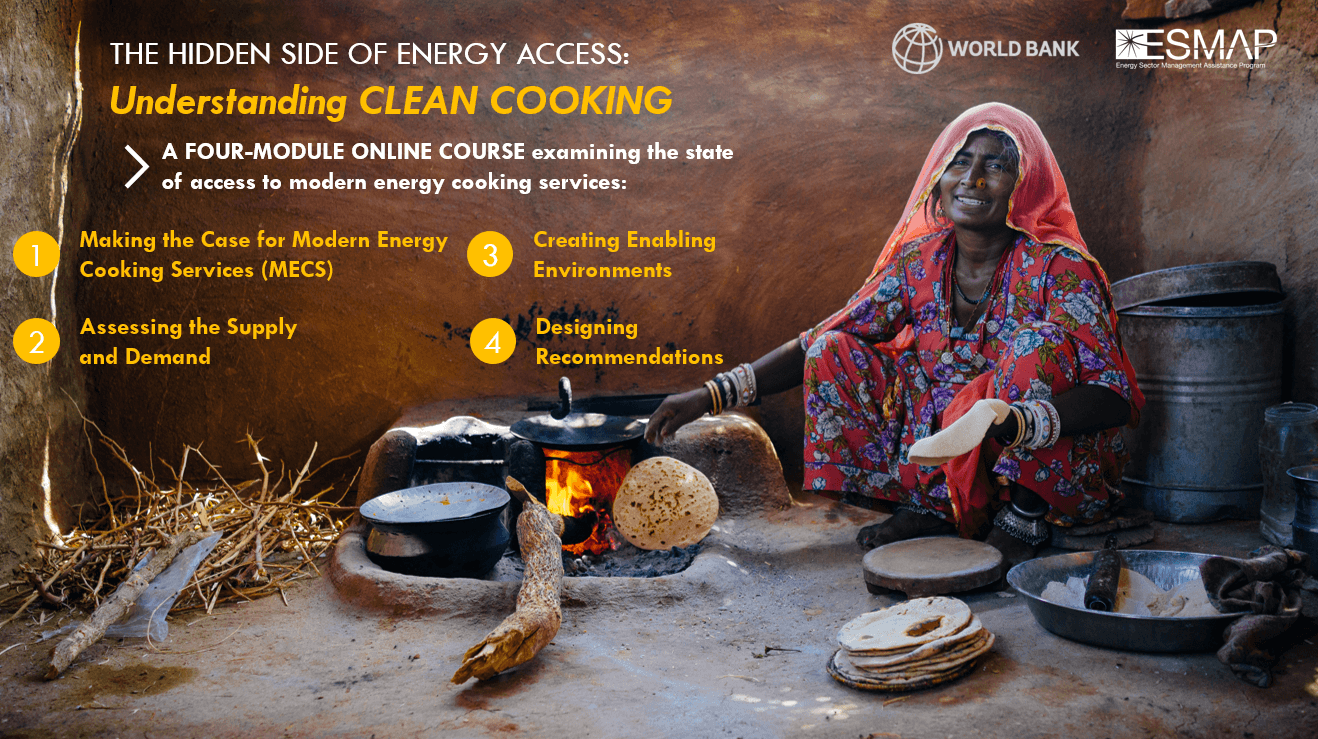Sit back and launch the new online course: The Hidden Side of Energy Access: Understanding Clean Cooking. But don't get too comfortable. For the first time in its history, the Energy Sector Management Assistance Program (ESMAP) reports that over four billion people–half of the global population–do not have access to modern energy cooking services (MECS) for their daily cooking needs. In other words, every other person on the planet lacks access to reliable, affordable, convenient, and safe fuel-stove solutions. The first of its kind, this four-module course seeks to bring this grave reality to the forefront of our minds as we spend more time in our kitchens than ever before.
As a development objective, clean cooking is often overlooked next to electrification targets and renewable energy efforts. It is surprising, given the detrimental impacts posed by the continued reliance on biomass fuels and rudimentary stoves on gender equality, public health, the environment, and the climate. Four million premature deaths are estimated to result from household air pollution (HAP) created by elementary fuel-stove combinations. At the same time, hours spent on fuel collection and cooking duties draw women and girls away from other productive activities, thus perpetuating intergenerational cycles of gender inequality. Moreover, greenhouse gas emissions and catalytic warming effects from black carbon emissions are additional consequences, not to mention forest degradation and deforestation resulting from biomass fuel consumption. Have we caught your attention? If so, you can explore these effects in even greater depth in Module 1 of the course.
What else to expect? In this course, you will be exposed to the Multi-Tier Framework (MTF), a user-centered tool for monitoring the cooking sector's progress using a broad set of household-level data. This tool has been used to estimate MECS access rates across Sub-Saharan Africa, Latin America and the Caribbean, and Asia. You will have the opportunity to map these trends in Module 2, where you'll also uncover demand- and supply-side dynamics that determine various levels of access. We haven't always used the contextualized MTF approach, however. In Module 3, you will explore the clean cooking sector's evolution, uncovering dichotomous approaches that historically dominated our thinking on clean cooking. Today, we make a case for the least-cost, best-fit method, a strategy to achieve clean cooking which acknowledges user needs, comparative advantages, and local market conditions. In Module 4, you will be guided through recommended actions for national governments, donors and development partners, and entrepreneurs and private investors. These provide a strategic vision for moving forward on the clean cooking agenda.
Acknowledging the fact that many of us already spend significant amounts of time in front of our screens, the course has been designed to produce as much engagement and reflection as possible. It features interactive video content, scenario exercises, supplementary reading materials, and check-for-understanding quizzes. You will meet Abuya, a mother of five living in rural Kenya, who faces affordability constraints in purchasing cooking fuel. You will engage with a case study on WANA Energy Solutions to explore the MTF attributes through an innovative Pay-As-You-Go model. An interactive map showcasing game-changing actors working in the clean cooking sector and an activity designing a results-based financing program will also be part of the course. Finally, you'll have the chance to explore the Clean Cooking Forum to understand how clean cooking commitments are achieved in practice.
In conjunction with the newest ESMAP report, this course is designed to convey information about clean cooking holistically, without losing the nuance and complexity required to make honest headway on the clean cooking agenda . Anyone from seasoned development practitioners to donors and investors to students is invited to participate in this course to gain a fundamental understanding of clean cooking. The course acknowledges that innovation and progress on this agenda require a candid understanding of the sector's history — including lessons learned — and an appreciation for the highly contextualized nature of cooking practices. Choices concerning fuel-stove technologies involve deeply-entrenched gender norms, consumer preferences, user needs and constraints, and behavioral aspects. These dynamics must be understood and integrated into our approaches. Progress will otherwise remain elusive. With this introduction, we invite you to launch the course and sit back (but don't relax).
This course came to fruition thanks to the tremendous support of the World Bank's Open Learning Campus (OLC), the learning platform hosting the four modules. The course benefited from funding from ESMAP and the Republic of Korea, Ministry of Economy and Finance under the OLC's Korea Program for Operational Knowledge.
Subscribe here to stay up to date with the latest Energy blogs.




Join the Conversation